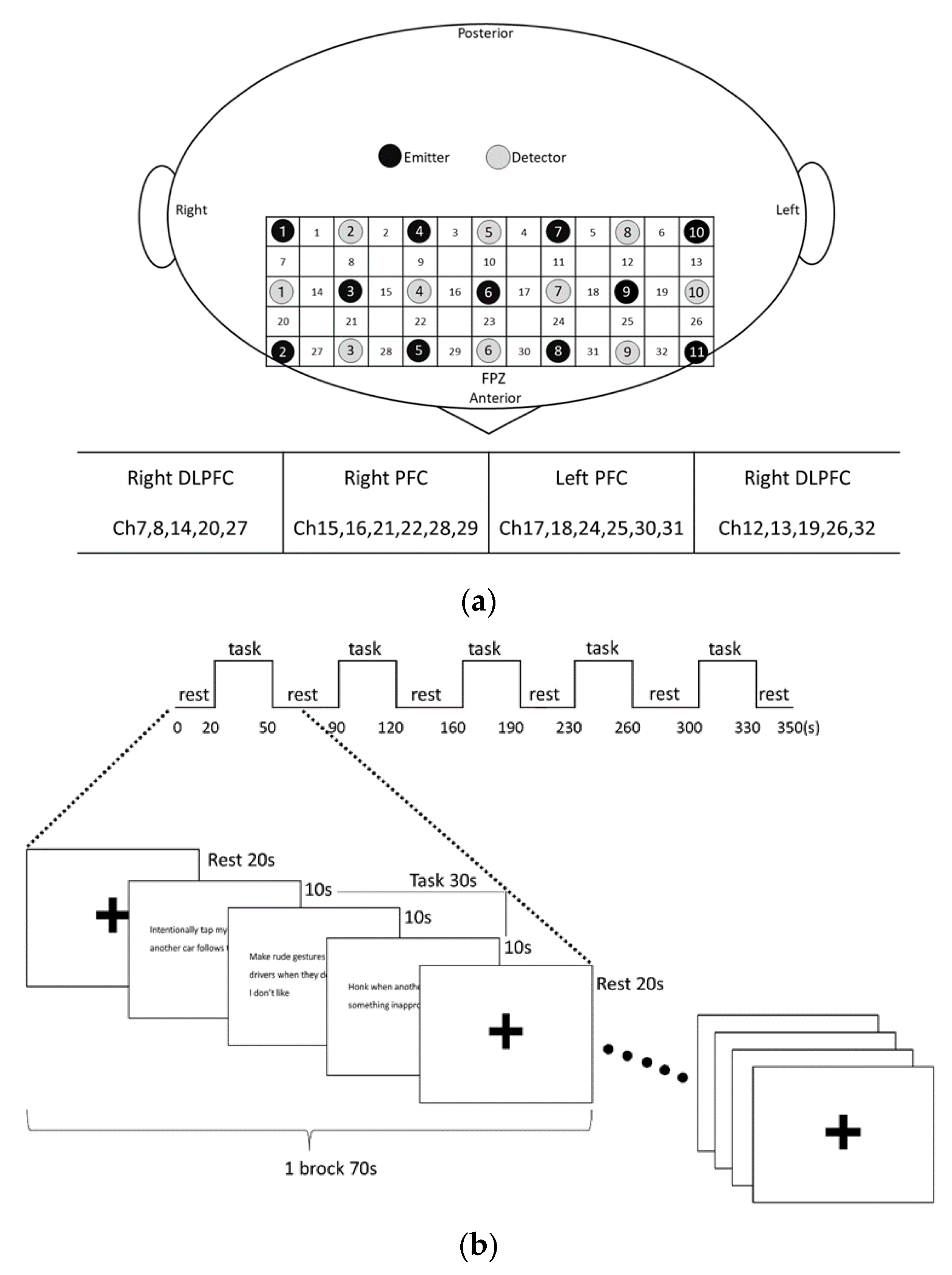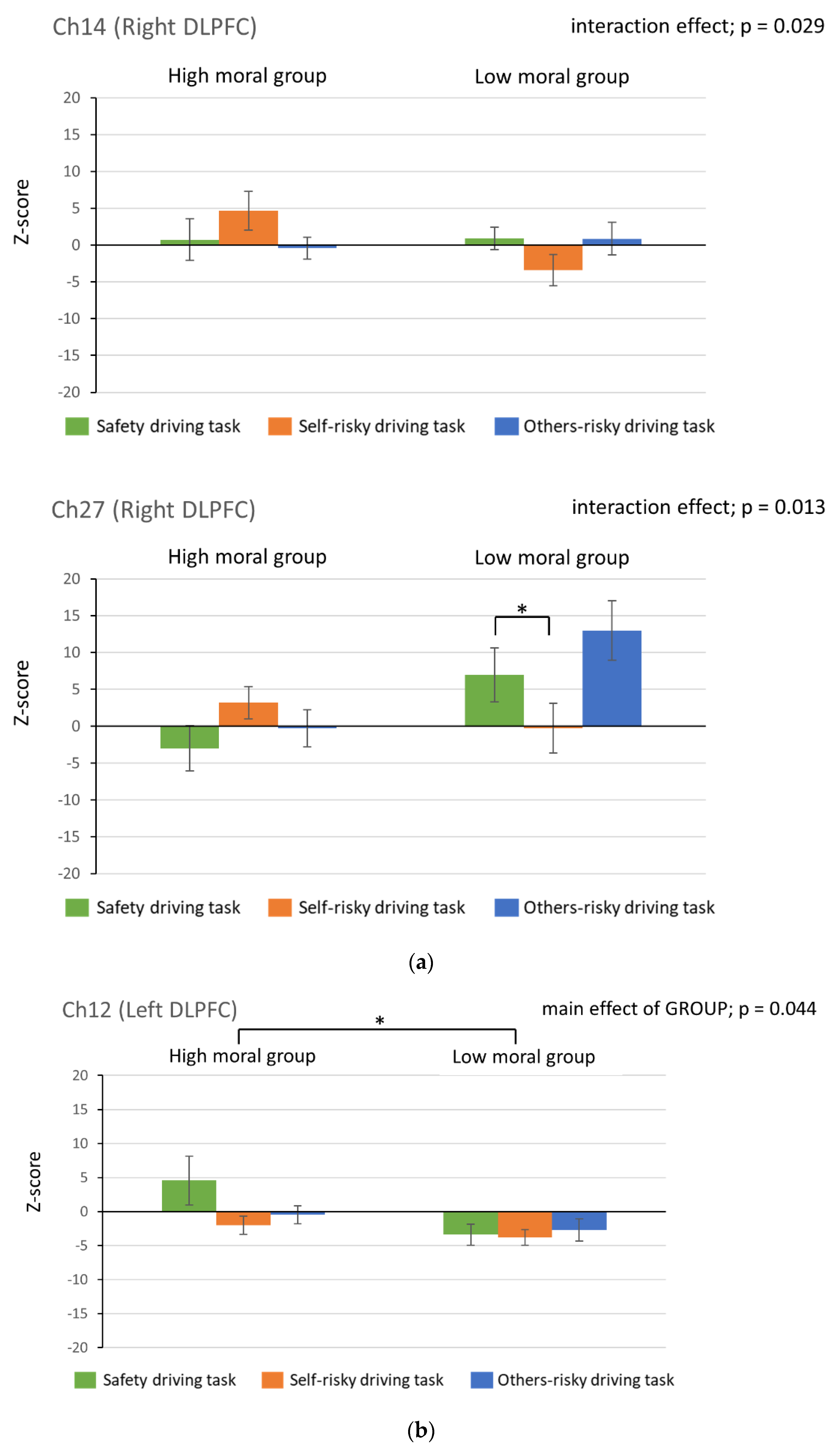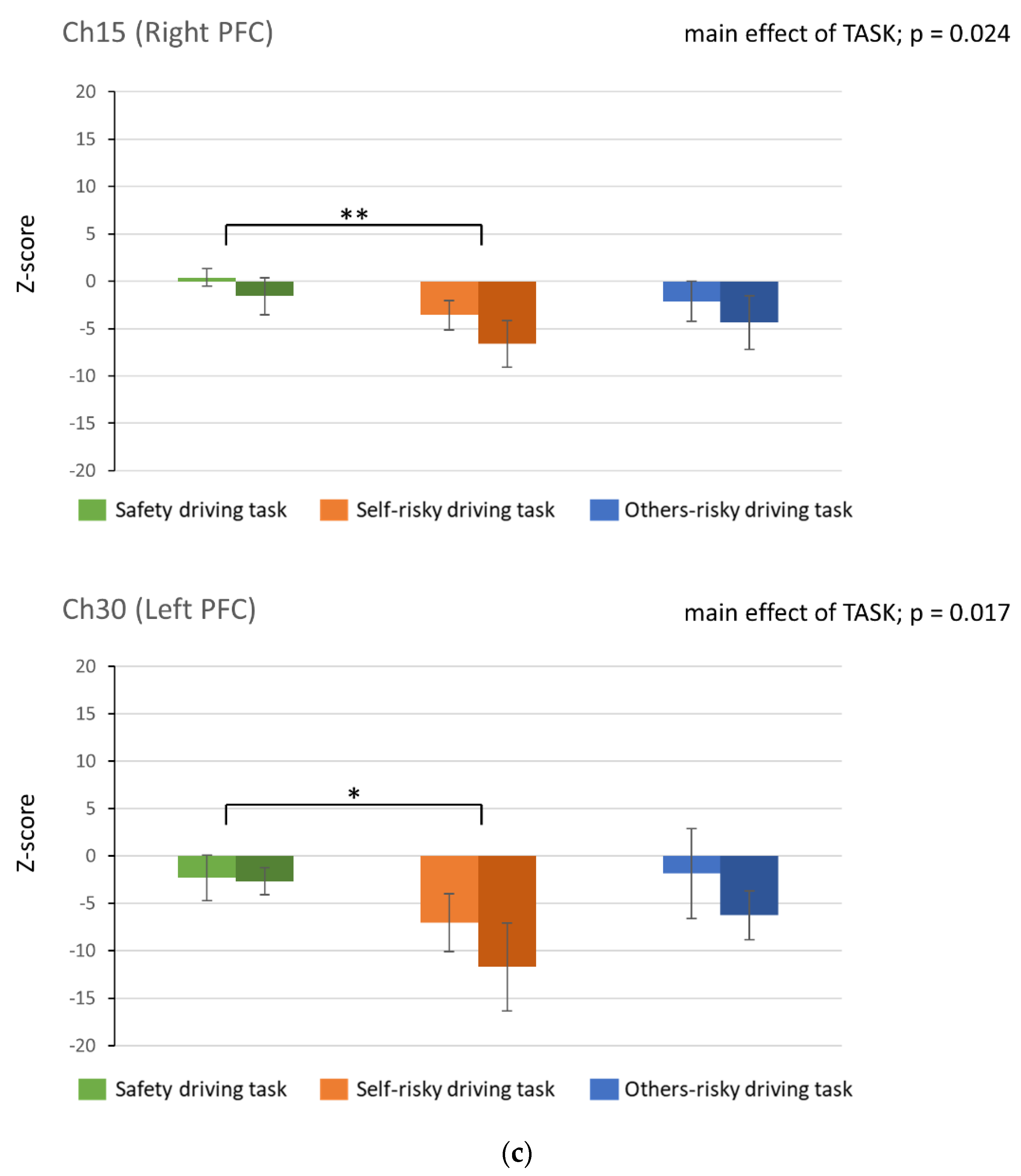Relationship between Moral Values for Driving Behavior and Brain Activity: An NIRS Study
Abstract
1. Introduction
2. Materials and Methods
2.1. Participants
2.2. Questionnaire on Moral Values for Driving Behavior
2.3. Research Procedure
2.4. Processing of NIRS Data and Selection of Areas of Interest
2.5. Statistical Analysis
3. Results
4. Discussion
5. Limitations
6. Conclusions
Author Contributions
Funding
Institutional Review Board Statement
Informed Consent Statement
Data Availability Statement
Conflicts of Interest
References
- Cociu, S.; Deleu, R.; Rimis, C.; Cebanu, S.; Cherecheș, R.M. Ethical Aspects in Road Traffic Safety and Driving Behavior Change. J. Intercult. Manag. Ethics 2022, 5, 57–69. [Google Scholar] [CrossRef]
- Global Status Report on Road Safety 2018. Available online: https://www.who.int/publications/i/item/9789241565684 (accessed on 25 October 2022).
- Road Traffic Injuries. Available online: https://www.who.int/news-room/fact-sheets/detail/road-traffic-injuries (accessed on 25 October 2022).
- Ghasem, M.; Mohammad, R.A.; Seyed, T.H.; Amin, H.; Kamran, B.L.; Yaser, S. An Epidemiologic Survey of Road Traffic Accidents in Iran: Analysis of Driver-Related Factors. Chin. J. Traumatol. 2013, 16, 140–144. [Google Scholar]
- Jiang, B.; Liang, S.; Peng, Z.R.; Cong, H.; Levy, M.; Cheng, Q.; Wang, T.; Remais, J.V.; Remais, J.V. Transport and Public Health in China: The Road to a Healthy Future. Lancet 2017, 390, 1781–1791. [Google Scholar] [CrossRef]
- Heydari, S.T.; Vossoughi, M.; Akbarzadeh, A.; Lankarani, K.B.; Sarikhani, Y.; Javanmardi, K.; Akbary, A.; Akbari, M.; Mahmoodi, M.; Shirazi, M.K.; et al. Prevalence and Risk Factors of Alcohol and Substance Abuse Among Motorcycle Drivers in Fars Province, Iran. Chin. J. Traumatol. 2016, 19, 79–84. [Google Scholar] [CrossRef] [PubMed]
- Harith, S.H.; Mahmud, N. The Relationship Between Norms and Risky Driving Behavior: A Systematic Review. Iran. J. Public Health 2020, 49, 211–220. [Google Scholar] [CrossRef] [PubMed]
- van den Berg, T.G.C.; Kroesen, M.; Chorus, C.G. Does Morality Predict Aggressive Driving? A Conceptual Analysis and Exploratory Empirical Investigation. Transp. Res. Part F 2020, 74, 259–271. [Google Scholar] [CrossRef]
- Chliaoutakis, J.E.; Demakakos, P.; Tzamalouka, G.; Bakou, V.; Koumaki, M.; Darviri, C. Aggressive behavior while driving as predictor of self-reported car crashes. J. Saf. Res. 2002, 33, 431–443. [Google Scholar] [CrossRef]
- Houston, J.M.; Harris, P.B.; Norman, M. The Aggressive Driving Behavior Scale: Developing a Self- Report Measure of Unsafe Driving Practices. N. Am. J. Psychol. 2003, 5, 193–202. [Google Scholar]
- Dula, C.S.; Ballard, M.E. Development and evaluation of a measure of dangerous, aggressive, negative emotional, and risky driving. J. Appl. Soc. Psychol. 2003, 33, 263–282. [Google Scholar] [CrossRef]
- Parker, D.; Manstead, A.S.R.; Stradling, S.G. Extending the Theory of Planned Behaviour: The Role of Personal Norm. Br. J. Soc. Psychol. 1995, 34, 127–138. [Google Scholar] [CrossRef]
- Haidt, J. The Moral Emotions. In Handbook of Affective Sciences; Davidson, R.J., Scherer, K.R., Goldsmith, H.H., Eds.; Oxford University Press: Oxford, UK, 2003; pp. 852–870. [Google Scholar]
- Tangney, J.P.; Stuewig, J.; Mashek, D.; Hastings, M. Assessing Jail Inmates’ Proneness to Shame and Guilt: Feeling Bad About the Behavior or the Self? Crim. Justice Behav. 2011, 38, 710–734. [Google Scholar] [CrossRef] [PubMed]
- Weiner, B. Intrapersonal and Interpersonal Theories of Motivation From an Attribution Perspective. Educ. Psychol. Rev. 2000, 12, 1–14. [Google Scholar] [CrossRef]
- Rozin, P.; Lowery, L.; Imada, S.; Haidt, J. The CAD Triad Hypothesis: A Mapping Between Three Moral Emotions (Contempt, Anger, Disgust) and Three Moral Codes (Community, Autonomy, Divinity). J. Pers. Soc. Psychol. 1999, 76, 574–586. [Google Scholar] [CrossRef]
- Huebner, B.; Dwyer, S.; Hauser, M. The Role of Emotion in Moral Psychology. Trends Cogn. Sci. 2009, 13, 1–6. [Google Scholar] [CrossRef]
- Montag, I.; Comrey, A.L. Internality and externality as correlates of involvement in fatal driving accidents. J. Appl. Soc. Psychol. 1987, 72, 339–343. [Google Scholar] [CrossRef]
- Deffenbacher, J.; Oetting, E.; Lynch, R. Development of a driving anger scale. Psychol. Rep. 1994, 74, 83–91. [Google Scholar] [CrossRef] [PubMed]
- Burns, C.P.; Wilde, G.J.S. Risk taking in male taxi drivers: Relationships among personality, observational data and driver records. Pers. Individ. Differ. 1995, 18, 267–278. [Google Scholar] [CrossRef]
- Deffenbacher, J.; Lynch, R.; Oetting, E.; Yingling, D. Driving anger: Correlates and a test of state-trait theory. Pers. Individ. Differ. 2001, 31, 1321–1331. [Google Scholar] [CrossRef]
- Iversen, H.; Rundmo, T. Personality, risky driving and accident involvement among Norwegian drivers. Pers. Individ. Differ. 2002, 33, 1251–1263. [Google Scholar] [CrossRef]
- Akbari, M.; Lankarani, K.B.; Heydari, S.T.; Motevalian, S.A.; Tabrizi, R.; Asadi-Shekari, Z.; Sullman, M.J.M. Meta-analysis of the Correlation Between Personality Characteristics and Risky Driving Behaviors. J. Inj. Violence Res. 2019, 11, 107–122. [Google Scholar]
- Lazuras, L.; Rowe, R.; Poulter, D.R.; Powell, P.A.; Ypsilanti, A. Impulsive and self-regulatory processes in risky driving among young people: A dual process model. Front. Psychol. 2019, 10, 1170. [Google Scholar] [CrossRef] [PubMed]
- Dashtestani, H.; Zaragoza, R.; Pirsiavash, H.; Knutson, K.M.; Kermanian, R.; Cui, J.; Harrison, J.D.; Halem, M.; Gandjbakhche, A.; Halem, M.; et al. Canonical Correlation Analysis of Brain Prefrontal Activity Measured by Functional Near Infra-red Spectroscopy (fNIRS) During a Moral Judgment Task. Behav. Brain Res. 2019, 359, 73–80. [Google Scholar] [CrossRef] [PubMed]
- Takahashi, H.; Yahata, N.; Koeda, M.; Matsuda, T.; Asai, K.; Okubo, Y. Brain Activation Associated with Evaluative Processes of Guilt and Embarrassment: An fMRI Study. Neuroimage 2004, 23, 967–974. [Google Scholar] [CrossRef] [PubMed]
- Roth, L.; Kaffenberger, T.; Herwig, U.; Brühl, A.B. Brain Activation Associated With Pride and Shame. Neuropsychobiology 2014, 69, 95–106. [Google Scholar] [CrossRef] [PubMed]
- Bastin, C.; Harrison, B.J.; Davey, C.G.; Moll, J.; Whittle, S. Feelings of shame, embarrassment and guilt and their neural correlates: A systematic review. Neurosci. Biobehav. Rev. 2016, 71, 455–471. [Google Scholar] [CrossRef]
- Zhu, R.; Feng, C.; Zhang, S.; Mai, X.; Liu, C. Differentiating guilt and shame in an interpersonal context with univariate activation and multivariate pattern analyses. NeuroImage 2019, 186, 476–486. [Google Scholar] [CrossRef] [PubMed]
- Dashtestani, H.; Zaragoza, R.; Kermanian, R.; Knutson, K.M.; Halem, M.; Casey, A.; Shahni Karamzadeh, N.; Anderson, A.A.; Boccara, A.C.; Gandjbakhche, A. The Role of Prefrontal Cortex in a Moral Judgment Task Using Functional Near-Infrared Spectroscopy. Brain Behav. 2018, 8, e01116. [Google Scholar] [CrossRef]
- Skurvydas, A.; Valančiene, D.; Šatas, A.; Mickevičiene, D.; Vadopalas, K.; Karanauskienė, D. Are motor and cognitive control, impulsivity and risk-taking behaviour as well as moral decision making determined by the activity of prefrontal cortex during Stroop test? Balt. J. Sport Health Sci. 2018, 1, 30–41. [Google Scholar] [CrossRef]
- Duan, L.; Feng, Q.; Xu, P. Using functional near-infrared spectroscopy to assess brain activation evoked by guilt and shame. Front. Hum. Neurosci. 2020, 14, 197. [Google Scholar] [CrossRef]
- Tangney, J.P.; Dearing, R.L. Shame and Guilt; Guilford Press: New York, NY, USA, 2003; pp. 1–40. [Google Scholar]
- Greene, J.D.; Nystrom, L.E.; Engell, A.D.; Darley, J.M.; Cohen, J.D. The neural bases of cognitive conflict and control in moral judgment. Neuron 2004, 44, 389–400. [Google Scholar] [CrossRef]
- Han, H.; Glover, G.H.; Jeong, C. Cultural influences on the neural correlate of moral decision making processes. Behav. Brain Res. 2014, 259, 215–228. [Google Scholar] [CrossRef]
- Han, H.; Chen, J.; Jeong, C.; Glover, G.H. Influence of the cortical midline structures on moral emotion and motivation in moral decision-making. Behav. Brain Res. 2016, 302, 237–251. [Google Scholar] [CrossRef] [PubMed]
- Importance of Left Dorsolateral Prefrontal Cortex in Moral Judgment Using Functional Near-Infrared Spectroscopy. Available online: https://opg.optica.org/abstract.cfm?URI=OTS-2018-JW3A.52 (accessed on 11 October 2022).
- Anderson, S.W.; Bechara, A.; Damasio, H.; Tranel, D.; Damasio, A.R. Impairment of social and moral behavior related to early damage in human prefrontal cortex. Nat. Neurosci. 1999, 2, 1032–1037. [Google Scholar] [CrossRef] [PubMed]
- Beer, J.S.; Heerey, E.A.; Keltner, D.; Scabini, D.; Knight, R.T. The regulatory function of self-conscious emotion: Insights from patients with orbitofrontal damage. J. Pers. Soc. Psychol. 2003, 85, 594–604. [Google Scholar] [CrossRef] [PubMed]
- Zhang, S.; Zheng, Y.; Wang, D.; Wang, L.; Ma, J.; Zhang, J.; Xu, W.; Li, D.; Zhang, D.; Li, D.; et al. Application of a Common Spatial Pattern-Based Algorithm for an fNIRS-Based Motor Imagery Brain-Computer Interface. Neurosci. Lett. 2017, 655, 35–40. [Google Scholar] [CrossRef]
- Kanda, Y. Investigation of the Freely Available Easy-to-Use Software ‘EZR’ for Medical Statistics. Bone Marrow Transplant. 2013, 48, 452–458. [Google Scholar] [CrossRef]
- Miller, E.K.; Cohen, J.D. An Integrative Theory of Prefrontal Cortex Function. Annu. Rev. Neurosci. 2001, 24, 167–202. [Google Scholar] [CrossRef]
- Paquette, V.; Lévesque, J.; Mensour, B.; Leroux, J.M.; Beaudoin, G.; Bourgouin, P.; Beauregard, M. “Change the mind and you change the brain”: Effects of Cognitive-Behavioral Therapy on the Neural Correlates of Spider Phobia. Neuroimage 2003, 18, 401–409. [Google Scholar] [CrossRef]
- Mah, L.; Arnold, M.C.; Grafman, J. Impairment of Social Perception Associated with Lesions of the Prefrontal Cortex. Am. J. Psychiatry 2004, 161, 1247–1255. [Google Scholar] [CrossRef]
- Riva, P.; Manfrinati, A.; Sacchi, S.; Pisoni, A.; Romero Lauro, L.J. Selective Changes in Moral Judgment by Noninvasive Brain Stimulation of the Medial Prefrontal Cortex. Cogn. Affect. Behav. Neurosci. 2019, 19, 797–810. [Google Scholar] [CrossRef]
- Anderson, S.W.; Barrash, J.; Bechara, A.; Tranel, D. Impairments of Emotion and Real-World Complex Behavior Following Childhood-or Adult-Onset Damage to Ventromedial Prefrontal Cortex. J. Int. Neuropsychol. Soc. 2006, 12, 224–235. [Google Scholar] [CrossRef] [PubMed]
- Horne, Z.; Powell, D. How Large is the Role of Emotion in Judgments of Moral Dilemmas? PLoS ONE 2016, 11, e0154780. [Google Scholar] [CrossRef] [PubMed]




| 1. Intentionally tapping my brakes when another car follows too closely |
| 2. Making rude gestures at other drivers when they do something I do not like |
| 3. Honking when another driver does something inappropriate |
| 4. Merging into traffic even when another driver tries to close the gap between cars |
| 5. Speeding up when another car tries to overtake me |
| 6. Following another car in front of me closely to prevent another car from merging in front of me |
| 7. Flashing my high beams at slower traffic so that it will get out of my way |
| 8. Following a slower car at less than a car’s length |
| 9. Driving 20 miles per hour above the speed limit |
| 10. Passing in front of a car at less than a car’s length |
| 11. Accelerating into an intersection when the traffic light is changing from yellow to red |
| 12. Shouting loudly when another driver does something inappropriate |
| 13. Driving while using a cellular phone, smartphone, etc. |
| 14. At a “stop”, slowing down but not coming to a complete stop |
| 15. Turning right and left without slowing down at intersections |
| High Moral Group Mean (SD) | Low Moral Group Mean (SD) | p-Value | |
|---|---|---|---|
| Male/Female (n) Age (years) Driving experience (years) | 5/4 | 5/4 | n.s. |
| 23.9 (5.7) | 25.9 (7.0) | n.s. | |
| 5.4 (6.0) | 7.4 (7.2) | n.s. |
Publisher’s Note: MDPI stays neutral with regard to jurisdictional claims in published maps and institutional affiliations. |
© 2022 by the authors. Licensee MDPI, Basel, Switzerland. This article is an open access article distributed under the terms and conditions of the Creative Commons Attribution (CC BY) license (https://creativecommons.org/licenses/by/4.0/).
Share and Cite
Kawabata, K.; Fujita, K.; Sato, M.; Hayashi, K.; Kobayashi, Y. Relationship between Moral Values for Driving Behavior and Brain Activity: An NIRS Study. Healthcare 2022, 10, 2221. https://doi.org/10.3390/healthcare10112221
Kawabata K, Fujita K, Sato M, Hayashi K, Kobayashi Y. Relationship between Moral Values for Driving Behavior and Brain Activity: An NIRS Study. Healthcare. 2022; 10(11):2221. https://doi.org/10.3390/healthcare10112221
Chicago/Turabian StyleKawabata, Kaori, Kazuki Fujita, Mamiko Sato, Koji Hayashi, and Yasutaka Kobayashi. 2022. "Relationship between Moral Values for Driving Behavior and Brain Activity: An NIRS Study" Healthcare 10, no. 11: 2221. https://doi.org/10.3390/healthcare10112221
APA StyleKawabata, K., Fujita, K., Sato, M., Hayashi, K., & Kobayashi, Y. (2022). Relationship between Moral Values for Driving Behavior and Brain Activity: An NIRS Study. Healthcare, 10(11), 2221. https://doi.org/10.3390/healthcare10112221






